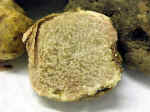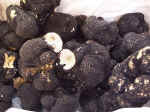Tuscan food and flavoursSan Miniato is one of the most productive truffle-rich areas of Europe. The white truffle (which is usually a pale ochre in colour) that grows in the San Miniato hills is the most valuable type known. However, if the San Miniato truffle is unique, there are numerous other agricultural products that contribute to the taste and flavours of San Miniato cookery. The wines and olive oils are the produce of a territory that is particularly suited to them, especially the production of Vin Santo (slightly sweet dessert wine), made from the white San Colombano grape variety. The artichoke of San Miniato, one of the most abundant and flavourful varieties, was famous even in the Medicean times. The Kentucky variety of tobacco has been imported from America for two centuries for production of the "Sigaro Toscano", the Tuscan cigar. The quasi-Romanesque shape of the tobacco drying sheds, similar to those found in Cuba, punctuates the San Miniato landscape. The culture of food and its flavours has undergone a notable revival during the past 30 years. The treatment and preparation of pork and blood products has once again come to life in the Longobard and mediaeval centre of San Miniato. The art of baking and Mediterranean treatment of flour also makes our pastries and baked goods excellent. Wonderful flavours still today come from the refectories of our ancient convents, our mediaeval tertiaries and over thirty manorial farms that were already listed in a feudal deed dating back to the year 938 A.D.
San Miniato TrufflesAn old folk saying, still today taught to children living in the San Miniato countryside, recounts that a little golden calf can be found between Doderi, Montoderi and Poggioderi (three sites mentioned in mediaeval documents kept in the Archives of San Miniato). It may seem odd, but the heart of the San Miniato truffle ground can be found in that Valdegola triangle. The white truffle from the San Miniato hills, a geographical truffle-producing area that extends towards the inland countryside of Pisa, is known as Tuber magnatum pico. This kind of underground fungus is the most valuable. Located a few centimetres deep, they can only be found in a limited number of areas favoured by Nature for the particular, almost mysterious, combination of forest fauna and geological substratum.
Our truffles have a reputation for quality not only because of the fertility of the woods where they grow, but also because of the care taken where they are gathered. Truffle collection is regulated by strict controls and a regional law that defines how they are gathered and marketed. They are gathered selectively and in moderation, and production is limited due to the brevity of their season (the three months of October, November and December). In fact, the value of the white truffle of San Miniato lies in its rarity. Although known since the Middle Ages, it has been over only a little more than 100 years that their collection has been organised by the area's family groups, now known as the Tartufai delle Colline Sanminiatesi (Truffle gatherers of the San Miniato Hills, created about twenty years ago). This organisation groups together more than 400 truffle hunters in the Egola, Elsa and Era Valleys, all tributaries of the Arno River. More than just truffle hunters, the families each have their own secrets handed down through the generations, their truffle dogs and their hidden paths in oak, poplar and holm oak forests. The truffle, though, does not just mean a unique taste: it is also local culture and business. For thirty years the Mostra Mercato Nazionale del Tartufo Bianco di San Miniato (The San Miniato National White Truffle Market), has transformed the city for the entire month of November into a huge open-air tasting workshop. Here the truffle is king, displayed in the historical Piazza del Duomo at the foot of the Rocca. Other squares also have their own markets, with typical flavours of the San Miniato hills, offered together with specialities from other Italian culinary cities. The Truffle Show, however, is just the peak of what this extraordinary season has to offer. In the heart of the land of truffles, deep in the woods and countryside, smaller and hidden festivals take place in October in little villages that are home to the oldest truffle dynasties: The Corazzano Festival, at the foot of the Romanesque parish of San Giovanni Battista, and the Balconevisi Festival, in the ancient village of the Florentine Strozzi family, when each quarter participates in a goose race. And in March, the early Marzuolo truffle can be tasted in Cigoli, birthplace of Lodovico Cardi who rivalled Correggio as the leader of Mannerism. San Miniato white truffle fairThe San Miniato National White Truffle Market is held here every year during the last
three weeks of November. It is an important, internationally recognised fair that hosts many gastronomic and cultural events.
Apart from selling fresh truffles in various parts of the historical centre of San
Miniato, we host stalls and markets where people can eat, drink and find all types of Tuscan products. What to watch for when buying trufflesWhile there is no consistent difference between white truffles from
different areas in terms of aroma and flavour, there are differences from year to year depending on the weather. For example, if, during a drought, the truffles suffer from dryness, they release a strong aroma when harvested but it
fades quickly. If the weather is too wet and damp, they have little perfume. You get the best truffles when they are in abundance because of good weather and the price is lower. The larger and more regularly formed truffles (rounded, without cavities and growths) cost more because, when they are cleaned, small particles don't fall off and they are easier to slice over dishes. Otherwise, unfortunately, malformed truffles are difficult to brush and often hold bits of clay in their cavities. The buyer ends up paying truffle prices for bits of clay. |
||||||

